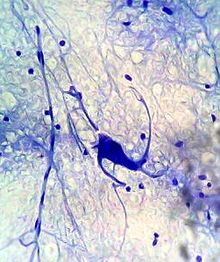
Back وقاية عصبية Arabic Neuroprotektion German Neuroprotección Spanish Neurobabesle Basque Neuroprotection French

Neuroprotection refers to the relative preservation of neuronal structure and/or function.[1] In the case of an ongoing insult (a neurodegenerative insult) the relative preservation of neuronal integrity implies a reduction in the rate of neuronal loss over time, which can be expressed as a differential equation.[1][2]
It is a widely explored treatment option for many central nervous system disorders including neurodegenerative diseases, stroke, traumatic brain injury, spinal cord injury, and acute management of neurotoxin consumption (i.e. methamphetamine overdoses). Neuroprotection aims to prevent or slow disease progression and secondary injuries by halting or at least slowing the loss of neurons.[3]
Despite differences in symptoms or injuries associated with CNS disorders, many of the mechanisms behind neurodegeneration are the same. Common mechanisms of neuronal injury include decreased delivery of oxygen and glucose to the brain, energy failure, increased levels in oxidative stress, mitochondrial dysfunction, excitotoxicity, inflammatory changes, iron accumulation, and protein aggregation.[4][3][5][6] Of these mechanisms, neuroprotective treatments often target oxidative stress and excitotoxicity—both of which are highly associated with CNS disorders. Not only can oxidative stress and excitotoxicity trigger neuron cell death but when combined they have synergistic effects that cause even more degradation than on their own.[7] Thus limiting excitotoxicity and oxidative stress is a very important aspect of neuroprotection. Common neuroprotective treatments are glutamate antagonists and antioxidants, which aim to limit excitotoxicity and oxidative stress respectively.
- ^ a b Casson RJ, Chidlow G, Ebneter A, Wood JP, Crowston J, Goldberg I (2012). "Translational neuroprotection research in glaucoma: a review of definitions and principles". Clinical & Experimental Ophthalmology. 40 (4): 350–357. doi:10.1111/j.1442-9071.2011.02563.x. PMID 22697056.
- ^ Patel, Hiteshkumar; Patel, Jayvadan; Patel, Anita (2024-04-15). "Enhancement of neuroprotective and anti-edema action in mice ischemic stroke model using T3 loaded nanoparticles". Medical and Pharmaceutical Journal. 3 (1): 1–12. doi:10.55940/medphar202463.
- ^ a b Seidl SE, Potashkin JA (2011). "The promise of neuroprotective agents in Parkinson's disease". Frontiers in Neurology. 2: 68. doi:10.3389/fneur.2011.00068. PMC 3221408. PMID 22125548.
- ^ Kaur H, Prakash A, Medhi B (2013). "Drug therapy in stroke: from preclinical to clinical studies". Pharmacology. 92 (5–6): 324–334. doi:10.1159/000356320. PMID 24356194.
- ^ Dunnett SB, Björklund A (June 1999). "Prospects for new restorative and neuroprotective treatments in Parkinson's disease". Nature. 399 (6738 Suppl): A32–A39. doi:10.1038/399a032. PMID 10392578. S2CID 17462928.
- ^ Andersen JK (July 2004). "Oxidative stress in neurodegeneration: cause or consequence?". Nature Medicine. 10 Suppl (7): S18–S25. doi:10.1038/nrn1434. PMID 15298006. S2CID 9569296.
- ^ Zádori D, Klivényi P, Szalárdy L, Fülöp F, Toldi J, Vécsei L (November 2012). "Mitochondrial disturbances, excitotoxicity, neuroinflammation and kynurenines: novel therapeutic strategies for neurodegenerative disorders". Journal of the Neurological Sciences. 322 (1–2): 187–191. doi:10.1016/j.jns.2012.06.004. PMID 22749004. S2CID 25867213.
© MMXXIII Rich X Search. We shall prevail. All rights reserved. Rich X Search